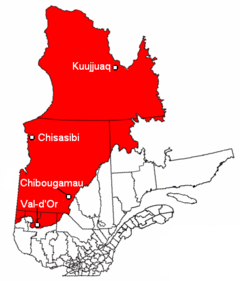James Bay and Northern Quebec Agreement
The James Bay and Northern Quebec Agreement (French: Convention de la Baie-James et du Nord québécois) is an Aboriginal land claim settlement, approved in 1975 by the Cree and Inuit of northern Quebec, and later slightly modified in 1978 by the Northeastern Quebec Agreement (French: Accord du Nord-Est québécois), through which Quebec's Naskapi First Nation joined the agreement. The agreement covers economic development and property issues in northern Quebec, as well as establishing a number of cultural, social and governmental institutions for Indigenous people who are members of the communities involved in the agreement.
Before Canadian Confederation, the lands of northern Quebec had been a part of Rupert's Land – the territory administered by the Hudson's Bay Company as part of the charter it received from King Charles II in 1670. In 1870, Rupert's Land was ceded to Canada, and in 1895 the region between the then-province of Quebec and the Hudson Strait became the District of Ungava of the Northwest Territories. In 1898, the border of Quebec was extended north to the Eastmain River. Quebec continued to claim the remaining District of Ungava, north of the Eastmain River, and in 1912 the area was transferred to Quebec, subject to the condition that a treaty be negotiated with the Indigenous peoples of the region recognizing their cultural rights and surrendering their title to the land to Quebec and Canada. There was at the time no pre-existing treaty covering that area. The government of Quebec did not immediately undertake such negotiations.
In the 1960s, Quebec began developing potential hydroelectric resources in the north, and in 1971 created the James Bay Development Corporation to pursue the development of mining, forestry and other potential resources starting with the James Bay Hydroelectric Project. This massive undertaking, which was directed by an increasingly assertive government of Quebec without consulting Indigenous people, was opposed by most of northern Quebec's Cree and Inuit. The Quebec Association of Indians – an ad hoc representative body of Indigenous northern Quebecers – sued the government and, on 15 November 1973, won an injunction in the Quebec Superior Court blocking hydroelectric development until the province had negotiated an agreement with the Indigenous nations.
This judgment was overruled by the Quebec Court of Appeal seven days later, after the government's efforts to quickly negotiate an agreement failed. Nonetheless, the legal requirement that Quebec negotiate a treaty covering the territory had not been overturned, even though construction continued.
Over the course of the next year, the government of Quebec negotiated the required accord. On 15 November 1974 – exactly a year after the Superior Court decision – an agreement-in-principle was signed between the governments of Canada, Quebec, publicly owned Hydro-Québec, the Grand Council of the Crees, headed by Billy Diamond, and the Northern Quebec Inuit Association.[1] The final accord – the James Bay And Northern Quebec Agreement (French: La Convention de la Baie James et du Nord québécois) – was signed on 11 November 1975. This convention originally only covered claims made by Quebec Cree and Inuit; however, on 31 January 1978, the Naskapi of Quebec signed a parallel agreement – the Northeastern Quebec Agreement – and joined the institutions established under the 1975 accord.
The Northern Quebec Inuit Association (NQIA) included as members Zebedee Nungak, Lazarusie Epoo[2] (Inukjuak), Tommy Cain, Johnny Watt, Charlie Watt (from Fort Chimo) and Jacob Oweetaltuk.[3] Charlie Watt acquired a James Bay development map and found two rivers were going to be impacted; the Great Whale and Caniapiscau were to be dammed and diverted.[4]
